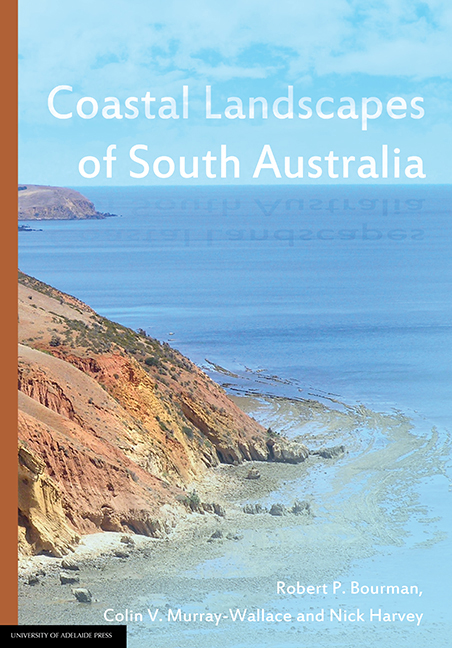Book contents
- Frontmatter
- Dedication
- Contents
- Preface
- Biographies
- Acknowledgements
- 1 Coastal landscapes of South Australia
- 2 The coast of metropolitan Adelaide
- 3 The Fleurieu Peninsula coast
- 4 The River Murray Estuary
- 5 The Coorong Coastal Plain and the Limestone Coast
- 6 The northern Gulf St Vincent tidal coastline (the Samphire Coast)
- 7 The Yorke Peninsula coastline
- 8 The northern Spencer Gulf coast
- 9 The Gulf Coast of Eyre Peninsula
- 10 The Bight Coast - West coast of Eyre Peninsula
- 11 Kangaroo Island
- 12 Explaining the coastal landscapes of South Australia - A synthesis
7 - The Yorke Peninsula coastline
Published online by Cambridge University Press: 25 July 2017
- Frontmatter
- Dedication
- Contents
- Preface
- Biographies
- Acknowledgements
- 1 Coastal landscapes of South Australia
- 2 The coast of metropolitan Adelaide
- 3 The Fleurieu Peninsula coast
- 4 The River Murray Estuary
- 5 The Coorong Coastal Plain and the Limestone Coast
- 6 The northern Gulf St Vincent tidal coastline (the Samphire Coast)
- 7 The Yorke Peninsula coastline
- 8 The northern Spencer Gulf coast
- 9 The Gulf Coast of Eyre Peninsula
- 10 The Bight Coast - West coast of Eyre Peninsula
- 11 Kangaroo Island
- 12 Explaining the coastal landscapes of South Australia - A synthesis
Summary
Introduction
Yorke Peninsula, with its distinctive leg-shaped form, was mapped by Matthew Flinders in 1802 and named after the First Lord of the Admiralty, Charles Philip Yorke. The peninsula covers an area of approximately 6800 km2: from north to south, it is 240 km long; its width varies from 50 km in its northern section to 32 km in the south between Hardwicke Bay and Wool Bay; and the east-west trending ‘foot’ is 80 km long (Figure 7.1).
Several distinctive geographical and geological features of the peninsula have had marked influences on the present coastline. The peninsula is of low and smooth relief, with the Arthurton Trig (229 m AHD, or Australian Height Datum, which approximates mean sea level) in the central north being the highest point. Generally, land surface elevations increase northwards from <100 m AHD in the south, rising gradually to 200 m in the north, partly reflecting tectonic tilting of the land. Elevations at the coast are well below 100 m, restricting the potential height of coastal cliffs. No permanent streams on the peninsula and few intermittent watercourses reflect the moderate rainfall of 355 to 500 mm, high evaporation rates associated with strong winds and hot summers, as well as the ubiquitous surface cover of rain-absorbing Cenozoic sediments with thin soil mantles, which cover more than 90% of the peninsula. Consequently, little continental sediment is delivered to the coast, and most beach sediment is derived from offshore sources and coastal erosion.
Why does Yorke Peninsula resemble ‘a very ill-shaped leg and foot’?
There is a strong structural control on the Yorke Peninsula coastline, due to tectonic activity (faulting), rock fabrics, structural factors, and varying degrees of susceptibility of rocks to erosion. These factors, together with wind, wave and tidal actions operating during repeated migrations of sea level, help to explain the character of the coastline. The most recent rise in sea level (18 to 7 ka), following the Last Glacial Maximum, essentially established the modern coastline of the peninsula.
Yorke Peninsula consists of a subdued north-south ridge of ancient coarsely crystalline basement rocks linked to the west and southwest Gawler Craton, with thin mantles of younger rocks and sediment. The oldest Gawler Craton rocks on Yorke Peninsula are those of the Corny Point Paragneiss (1920 to 1845 ± 6 Ma).
- Type
- Chapter
- Information
- Coastal Landscapes of South Australia , pp. 197 - 242Publisher: The University of Adelaide PressPrint publication year: 2016

